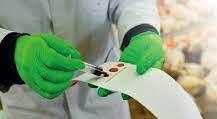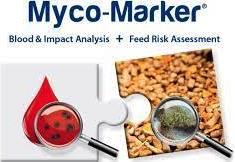 Innovad has introducedis offering the Myco-Marker®, a specific diagnostic service to confirm the presence of mycotoxicosis in flocks. This approach supplements traditionally, feed assay for an individual or a range of known pathogenic mycotoxins is used to ascertain their presence and levels in feed ingredients in order to assess risk and implement corrective action.
Innovad has introducedis offering the Myco-Marker®, a specific diagnostic service to confirm the presence of mycotoxicosis in flocks. This approach supplements traditionally, feed assay for an individual or a range of known pathogenic mycotoxins is used to ascertain their presence and levels in feed ingredients in order to assess risk and implement corrective action.

Innovad has developed the RISE approach to detecting and manageing mycotoxicoseis. The system is intended to anticipate both subclinical and performance-related effects of mycotoxin contamination inof feed ingredients. The RISE approach comprises: -
R - Risk evaluation.
I – Impact on performance and financial return as a result of mycotoxicoses.
S – Strategy to limit the impact of mycotoxicoses.
E - Evaluation of remedial and management modalities and calculation of the benefit-to-cost ratio of interventions.
 A consideration of the diagnostic advantages of Myco-Marker® are timely, given that harvesting of the 2023 corn crop has commenced. Dry weather during the stage of silking in June and July created the likelihood of fungal contamination and the elaboration of mycotoxins for much of the U.S. corn crop. This was has been promoted by subsequent rainfall and high humidity during August and early September leading into harvest.
A consideration of the diagnostic advantages of Myco-Marker® are timely, given that harvesting of the 2023 corn crop has commenced. Dry weather during the stage of silking in June and July created the likelihood of fungal contamination and the elaboration of mycotoxins for much of the U.S. corn crop. This was has been promoted by subsequent rainfall and high humidity during August and early September leading into harvest.
Conventional analysis for ingredients or feed comprises:-
On farm or in-mill mConventional mycotoxin assays include the uses of rapid test kits applying immunoassay technology. Results are These provide either qualitative or semi-quantitative results but the range of tests available is generally confined to the five most commonly encountered mycotoxins including aflatoxins, DON, zearalenone, ochratoxin and T-2.
More sophisticated GLC assay performed by suitably equipped laboratories can provide accurate, sensitive and quantitative results analyzing for as many as 36 mycotoxins.
Irrespective of the specificity and sensitivity of immuno-based kits and the more advanced but expensive GLC assays, the problem inof monitoring for mycotoxins is represented by a substantial an immense inherent sampling error. A violative aflatoxin level of 100 ppb can be produced by less than a handful of contaminated kernels distributed inwithin a ton of corn. Protocols including stratifying and replicating of sampling and repetition are practicedhave been developed in an attempt to overcome the restraints toproblem of obtaining representative specimens. Sampling error remains as a major obstacle into determining the level of contamination that may be present in a feed sample of less than five pounds derivedobtained from a barge, rail car or a trailer load of corn, DDGS or other ingredient.
Recent analytic advances ments, validated and reported in peer-reviewed literature, offer a broader and more direct alternative to detection of mycotoxicosis that withoffers increased accuracy and far lower minimal risk of error attributed to sampling-induced error. The presence use of biomarkers, specifically those found in the blood of birds and animals consuming feeds containing ingredients the feed(s) of concern, allows for quantitative measurement of a wide range of mycotoxins. The presence of metabolites of mycotoxins in blood confirms and known metabolites that represent actual exposure. Innovad® has developed MycoMarker®, a comprehensive protocol, MycoMarker®, that combines this blood assayblood testing with high-resolution HR LC-MS/MS feed testing to give producers a unique and powerful management diagnostic procedure to respond to ingredient contaminationtool. The blood assay test measures 36 toxins and metabolites, allowing assessment of the risk from 23 different mycotoxins – including key ‘emerging’ mycotoxins not identifiedfound in conventionalstandard feed analysestests.
Last years, started to be possible to analysis mycotoxin biomarkers in blood, concluding mycotoxin biomarkers provide exposure assessment in more accurate way than feed analysis. For this reason, Innovad developed Myco-Marker® assay. Theis service Myco-Marker® assay determines the presence of specific mycotoxin metabolites in the blood of flocks and herds. There is a direct correlation between intake of contaminated feed and the presence of as many as 36 mycotoxin biomarkers.
The Myco-Marker® test procedure is simple to perform. A blood sample taken from a chicken or hog is transferred to an FTCA card that is shipped to Innovad, accompanied by a submission form incorporating a questionnaire. The sample is then assayed by a dedicated laboratory operated by theat the University of Ghent in Belgium. T and the results including an interpretation and recommendation are returned to the submitter by Innovad. A sample of feed is also requiredprovided for parallel routine spectrophotometricGLC assay as anto attempt to correlate the quantum of mycotoxins present in diets with and the level of mycotoxin metabolites in blood. Studies over the past decade have demonstrated that approximately 80 percent of diagnoses of mycotoxicoses based on Myco-Marker® assays bloodthat samples detectiednoting the presence of mycotoxin metabolites would have been missed with only an assay of a single feed sample.
Recent studies have demonstrated the synergistic effect of mycotoxins. From over 7,000 samples submitted for Myco-Marker® analysis over a decade (>7,000), Innovad has determined that 15 percent of feed samples show four or more mycotoxins. In contrast, 72 percent of corresponding blood samples showed five or more mycotoxins attesting to the inherent sampling error associated with the “grab-and-send” approach to routine monitoring of feed. EThe large co-exposure to combinations ofdifferent mycotoxins is aof concern asR recent studies have demonstrated continue to demonstrate the synergistic effect of concurrent intake of multiple -mycotoxinss exposure..
It is important to correlate performance data and histopathology with the results of the Myco-Marker® assay.In the This is inherent to the evaluation component of the RISE approach to managing mycotoxicosis., it is important to correlate performance data with the results of the Myco-Marker® assay. There is growing evidence that immunosuppression associated with mycotoxins in addition to their direct effect on organ systems can predispose and exacerbate necrotic enteritis in broilers, precipitated by subclinical coccidiosis. In breeders and commercial laying hens, elevated flock mortality is encountered from the ruptured liver syndrome in additiontogether with depressed peak production and reduced persistence of laying. These effects are due to both primary mycotoxicoses but also to synergistic interaction between the major mycotoxins and emerging mycotoxins including enniatin B1, beauvericin and tenuazonic acid.
Application of the Innovad monitoring approach using the highly specific Myco-Marker® assay, combined with spectrophotometric GLC feed assay can guide managers in selecting an appropriate preventive strategy. Alternativespproaches may include assay of incoming consignments with rejection or blending of contaminated ingredients, if practical. This is usually based on rapid assays of ingredient samples at the time of delivery using immuno-based test kits. If known contamination is detected using the Myco-Marker® system or by the less sensitive sampling of ingredients for assay, mycotoxin binders can be added to feed. These commercially available products demonstrate varying levels of binding efficacy both in vitro and in vivo. Mycotoxin binders include inorganic absorbents such as activated clay, bentonite and modified aluminosilicate. Organic absorbents comprise glucomannan derived from yeast cell walls. C or combinations of the two adsorbent categories are available and will be reviewed in a subsequent posting.
Information provided by the Myco-Marker service is also being used to evaluate the effectiveness of current or test programs under on-farm conditions; to compare the efficacy of different mycotoxin mitigation strategies; and, to utilize data correlating mycotoxin exposure to other health issues to improve ROI calculations for preventive investments.
Control of mycotoxicosis exemplifies the Deeming Dictum of “if you can’t measure it, you can’t control it”. The Innovad patent-pending Myco-Marker® assay is a substantialconsiderable advancement over conventional feed assay since it specifically quantifies the presence of mycotoxin metabolites in the blood of chickens and turkeys, confirming ingestion and degradation.